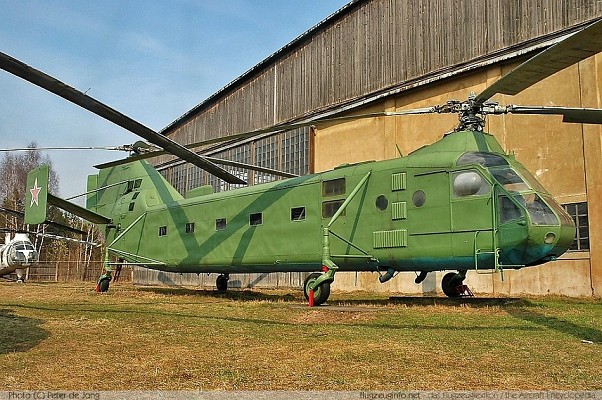Yak-24
NATO: Horse
Overview

Yak-24
A Yak-24 preserved in a museum.
Source: Peter de Jong @ www.horizonten.nl -
© copyright lies with original owner
1959 (operational use)
1952 - 1955 (Soviet state tests)
Letayushchiy Vagon (Russian nickname)
Russian for "flying railroad car"
Description
Introduction
The Yak-24 is an early Cold War era transport helicopter of Soviet origin. It was produced in the late 1950's to provide more cargo carrying capacity than the Mi-4 Hound. It was the first and last attempt of the Yakovlev design bureau to develop a helicopter. Despite breaking various records it was an unsuccessful design. With the introduction of the much more capable Mi-6 the Yak-24 was soon forgotten.
Layout
The design of the Yak-24 is very basic and straightforward. A long box shaped chassis makes up the airframe. The landing gear is fitted to large struts at the front and back. A set of tandem rotors at the front an back provide lift. Two Shvetsov ASh-82V radial engines provide power to the rotors, each engine being able to provide power to both rotors. Despite using the proven rotors and engines of the Mi-4 Hound the Yak-24 proved to mechanically unreliable. The Yak-24 was intended as troop transport and was not armed. The Yak-24 was a very basic design and did not feature any special avionics or sensors. Operating it at night would have been very hard, if not impossible.
Cargo capacity
The first versions of the Yak-24 could carry 30 troops, 18 stretchers or 3 t of cargo. The improved Yak-24U could carry 40 troops or 3.5 t of cargo. The large airframe allowed for 2 GAZ-69A or light anti-tank guns to be carried. The latest Yak-24A was also used as a flying crane and could lift up to 5 t of external cargo.
Mobility
The tandem rotor setup made the Yak-24 hard to fly. The powerful engines provide enough power to reach a speed of 195 km/h with a limited amount of cargo. The range is a modest 430 km.
Users
The Yak-24 was only operated by the USSR. Due to the technical problems a small amount was produced and had a short service life. A small amount was produced for civilian use and operated by Aeroflot.
Variants

Yak-24
Yak-24 in flight.
Source: www.snariad.ru -
© copyright lies with original owner